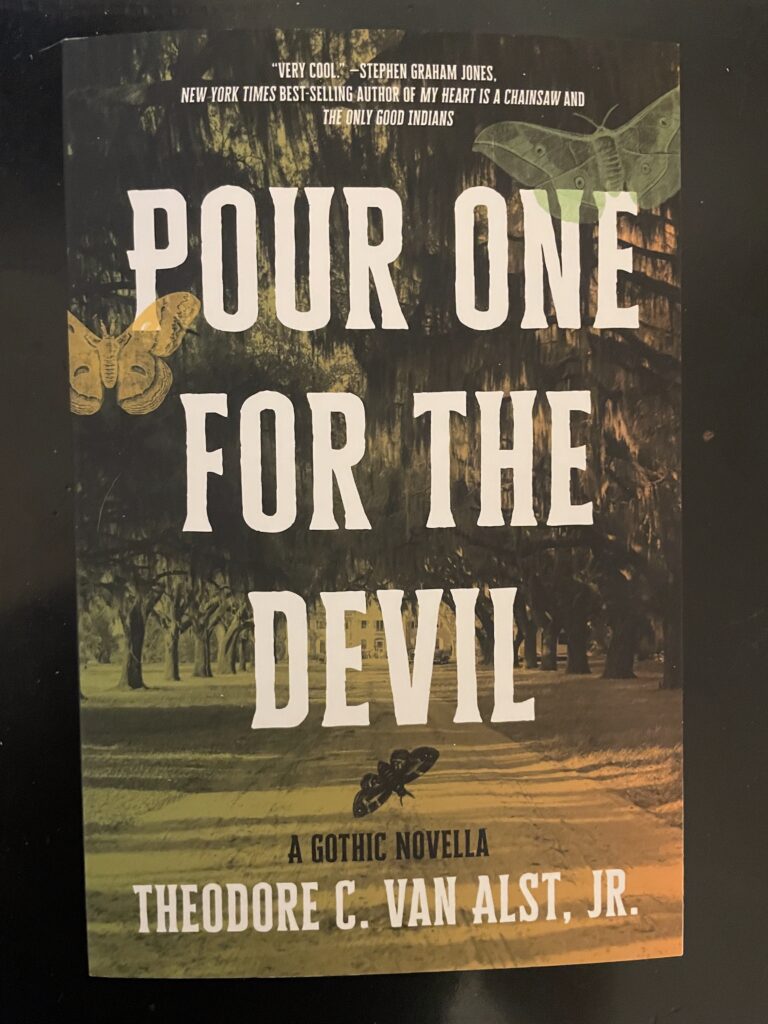“He held his hands up…So much for visiting a quaint southern mansion and lecturing to an elderly historical society.”- Theodore C. Van Alst Jr, ‘Pour One For The Devil’
One thing I like about Gothic fiction is all the talking. Gothic writers love taking a protagonist who thinks they know something about the world and putting them in a room some horrifying ancient entity that totally upends everything they’ve ever perceived. Think Jonathan Harker’s first dinner in Dracula’s castle, think Noemí sitting down with those eugenics freaks in Mexican Gothic, think hardened, world-weary Daniel Molloy first turning on his tape recorder for Louis in Interview With A Vampire. Think basically the entirety of the Justin Long/Kate Bosworth will they/won’t they rom-com House Of Darkness. This week, I read a Gothic novella. I knew I was in for some wild stuff at the end—I was even racing to the conclusion because a good Gothic novella makes the buildup too much to bear—but I got most excited when everyone sat down at the dinner table. What’s your favorite dinner in Gothic fiction?
What I’ve Been Reading This Week:
A novella from Lanternfish Press, easily one of the better-named presses we have (they also published Ship Of Fates, as well as the Carmen Maria Machado-introduced Carmilla that came out a few years back). A book that features some Sea Island history, some Gullah history, and some Indigenous history to go with its ghosts—extremely Chris-core themes, as my beloved Bob Sykora would say. A novella I could hardly wait to read, after reading this author’s short story in Never Whistle At Night, aka the Indigenous dark fiction anthology that he co-edited. I’m talking, of course, about Pour One For The Devil by Theodore C. Van Alst, Jr.

Pour One For The Devil by Theodore C. Van Alst, Jr: another great thing about Gothic novellas is that they can have a pretty simple, predictable plot, and still be a wholly unique and incredible experience. The joys with Gothic are in the language, the abundance of sensory detail, and exactly how messed up things get at the end. A lot more happens within this standard scaffolding than usually fits into a sub-100-page book. Our haunted house is an old plantation in Gullah territory. Our narrator is an Indigenous professor who has been invited to have dinner and give a talk by an old, moneyed white lady. The plantation house is staffed by three Gullah women. You already know ghosts live here.
Dr. Van Vierlans is a writer and academic who has extensively studied the Gullah people, and even speaks Gullah. He himself is from Chicago, and the book talks a bit about feeling disconnected from Indigenous culture and history by virtue of living in a city (if his tribe is mentioned, I cannot remember and cannot find it). Both peoples can claim both extreme oppression and extreme resilience in the face of the USian project. To invoke these cultures is to invoke defiantly open wounds to white supremacy, and having these characters back-talk a plantation owner while cheerfully downing all of her expensive Scotch is extremely cathartic. Putting them—Dr. Van Vierlans and house staff Delilah, Beryl, and Pearl—at the center of a Gothic haunted house novel is the kind of move you’d think would all over USian literature at this point, but is somehow not. The sins of Mrs. Lizzie and her family run deep, through history and to the present. The characters spend the whole novel drinking. By the end, you, the reader feel it. The radical in me wants to say that the hazy heads of our characters by novel’s climax is a metaphor for how capitalism and empire seek to keep its subjects confused and unsure of what’s really going on. Or is this just a cautionary tale about trusting Southern hospitality? Either way, if you want a short, exciting read for spooky season, pick this one up.
Also, if you want to read new Theodore C. Van Alst, Jr., while also reading along with this blog? You got a few days left to preorder The El, which drops on August 12. Unless something goes wrong with my pickup order at Women and Children First (never happened before, but I get superstitious whenever I speak plans aloud), I am reading it for the blog on Friday, August 22. Read a book with yr man the shipwrecked sailor!
LINKS!
Something to listen to while you browse? How about another Las Guaracheras track? Let’s do it. Here’s “Cantale a la vida.”
- Iilaatawiaanki (We speak a language) by Paul Dailing in Chicago Reader. Sub-hed: the Miami-Illinois speakers of Chicago wake a sleeping tongue
- “The Pit and the Penitent” by Steve Toase in Kaleidotrope
- The “Quaker Comet” Was The Greatest Abolitionist You’ve Never Heard Of by Marcus Rediker in Smithsonian Magazine
- Hot-Blooded: Universal Monsters and Romance by Emma Cole in Nightmare
- “Volcano People” by Richard Mirabella in hex
What’re you still doing here? Don’t you know Micah and Brendan have a show?
If you work in the service industry, may you clean up in tips this weekend. Hey, if you go get drinks after your shift, that’s cool. You gotta unwind after work, and blowing off steam with coworkers is a time-honored tradition. Bitching about your bosses, even more so. Just—keep your wits about you more than Dr. Van Vierlans, yeah? Be every bit as respectful to your bosses as Delilah, Pearl, and Beryl are to theirs. Just proceed as if the bosses always have designs on your doom, somehow.
Sorry you got an email,
Chris

